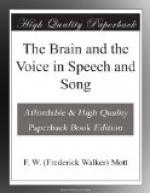This woman died of tuberculosis seven years after the second attack, and examination of the brain post-mortem revealed the cause of the deafness. There was destruction of the centre of hearing in both hemispheres (vide fig. 17), caused by blocking of an artery supplying in each hemisphere that particular region with blood. The cause of the blocking of the two arteries was discovered, for little warty vegetations were found on the mitral valve of the left side of the heart. I interpreted the two attacks thus: one of these warty vegetations had become detached, and escaping into the arterial circulation, entered the left carotid artery and eventually stuck in the posterior branch of the middle cerebral artery, causing a temporary loss of word memory, consequently a disturbance of the whole speech zone of the left hemisphere. This would account for the deafness to spoken language and loss of speech for a fortnight, with impairment for more than a month, following the first attack. But both ears are represented in each half of the brain; that is to say, sound vibrations entering either ear, although they produce vibrations only in one auditory nerve, nevertheless proceed subsequently to both auditory centres. The path most open, however, for transmission is to the opposite hemisphere; thus the right hemisphere receives most vibrations from the left ear and vice versa. Consequently the auditory centre in the right hemisphere was able very soon to take on the function of associating verbal sounds with the sense of movement of articulate speech




